英语故事教学案例
托班英语故事教案

托班英语故事教案一、教学目标1.能够借助英语故事,培养幼儿对英语的兴趣。
2.能够理解英语故事中的主要内容,提高幼儿的听力能力。
3.能够通过英语故事,学习和掌握一些基本的英语单词和表达方式。
二、教学内容1.教学主题:英语故事《The Lion and the Mouse》2.教学时长:30分钟3.教学工具:投影仪、故事书、图片、卡片等。
三、教学步骤步骤一:导入新知1.教师用PPT展示一组有关“动物”的图片,引发幼儿对动物的兴趣,并与幼儿一起讨论这些动物的名称和特征。
2.引导幼儿观察图片,并学习并模仿发出这些动物的声音,如“鸟儿叫唤的声音是什么样的?”、“狗狗叫唤的声音是什么样的?”等。
步骤二:讲述故事1.教师向幼儿展示故事书《The Lion and the Mouse》,让幼儿观察故事中的插图。
2.教师用简单的语言和表情,朗读故事的主要内容,并注重语音语调的模仿,让幼儿能够感受到故事的情节和情感。
步骤三:理解故事1.教师使用简单的英语例句向幼儿介绍故事中的关键词汇和表达方式。
比如,“lion”是什么意思?“mouse”是什么意思?等等。
2.教师提问幼儿一些与故事相关的问题,以检查幼儿的理解程度。
比如,“为什么老鼠要救狮子?”、“老鼠帮助狮子时发生了什么?”等等。
步骤四:小组讨论1.将幼儿分成小组,让他们自己讨论并回答一些与故事相关的问题。
比如,“你们觉得这个故事有什么好玩的地方?”、“你会帮助别人吗?为什么?”等等。
2.通过小组讨论,培养幼儿的合作能力和表达能力。
步骤五:游戏与活动1.制作一套动物卡片,让幼儿在教师的指导下,用英文单词和图片配对,并模仿相应的动物叫声。
2.教师指导幼儿做一个简单的角色扮演游戏,让一部分幼儿扮演狮子,一部分幼儿扮演老鼠,通过互动来加深对故事情节的理解。
步骤六:结束活动1.教师总结整个教案的内容,再次强调故事中传达的道德教育和友善的重要性。
2.教师鼓励幼儿根据故事和活动的体验,用绘画或写作的方式表达他们对故事的理解和想法。
英语教学教育故事案例(2篇)

第1篇In the heart of a bustling city, nestled within a small, underprivileged school, there stood a classroom filled with the echoes of youthful energy and the promise of endless possibilities. It was here, in Room 203, that Ms. Liu, a dedicated English teacher, embarked on a journey to transform the lives of her students through the language of English.The Classroom: A Mixed Bag of ChallengesThe class of 203 was a microcosm of the world outside. It was a diverse group of students, each with their own unique set of challenges and aspirations. There were students who had never spoken a word of English, those who had basic knowledge, and a few who could hold a conversation with relative ease. The room was a cacophony of languages, with whispers of Mandarin, Hindi, and Spanish mingling with the occasional burst of English.Ms. Liu understood that the first step in teaching English was to create a welcoming and inclusive environment. She started each lesson with a simple greeting in Mandarin, followed by a translation into English. This helped to bridge the communication gap and made the students feel valued and understood.The Student: Xiao MingAmong the students, Xiao Ming stood out. He was a bright, inquisitive boy with a natural curiosity for learning. However, Xiao Ming faced a significant challenge: he was shy and hesitant to speak in front of others. This reticence was not uncommon among students from his background, who often felt insecure about their English proficiency.Ms. Liu noticed Xiao Ming's struggle and decided to take a different approach. Instead of pushing him to speak, she encouraged him to listen and participate in group activities. She believed that confidence could be built through small, achievable goals.The Power of PatienceOne day, during a reading activity, Ms. Liu noticed Xiao Ming frowningat his book. He seemed to be having trouble understanding the text. Sensing his frustration, she decided to sit beside him and help him through the passage."Xiao Ming, what does this word mean?" she asked, pointing to adifficult word in the text.Xiao Ming hesitated before whispering the translation in Mandarin."Let's try to say it in English," Ms. Liu encouraged, her voice gentle and reassuring.With a hesitant smile, Xiao Ming repeated the word, this time in English. The room fell silent, and all eyes were on him. But Xiao Ming didn't flinch. He continued to participate, his confidence slowly growing with each word he pronounced correctly.Over the next few weeks, Ms. Liu continued to support Xiao Ming in his English learning journey. She would often ask him to read a sentence or explain a concept in English, and each time, Xiao Ming's voice grew louder and more confident.The Ripple EffectAs Xiao Ming's confidence grew, so did his classmates'. They began tosee him as a role model, someone who was overcoming his fears and embracing the challenge of learning English. This inspired others tostep out of their comfort zones and participate more actively in class.One day, during a group discussion, Xiao Ming volunteered to speak. His voice was clear and confident, and his classmates listened intently. The teacher praised him for his courage and his newfound ability to express himself in English.The Lesson LearnedThe story of Xiao Ming and Ms. Liu is a testament to the power of patience, understanding, and a supportive learning environment. It showsthat every student has the potential to learn and grow, given the right guidance and opportunities.Ms. Liu's approach to teaching English was not about pushing her students to perform but about nurturing their natural curiosity and encouraging them to take small, manageable steps towards their goals. Her patience and dedication paid off, not just for Xiao Ming, but for the entire class.In the end, Room 203 became more than just a classroom; it became a place where dreams were nurtured, fears were conquered, and a new language was embraced. The lessons learned in that room extended far beyond the confines of English language education; they were lessons in courage, resilience, and the importance of never giving up.第2篇Introduction:English teaching has always been a challenging yet rewarding field. It requires patience, creativity, and a deep understanding of the students' needs. This case study focuses on a teacher's journey in helping a student overcome his fear of English and unlocking his potential. Through this story, we aim to shed light on the importance of personalized learning, empathy, and effective teaching strategies in the field of English education.Background:The story takes place in a public school in a small town. The protagonist, Mr. Smith, is a dedicated English teacher who has been teaching for 15 years. One day, he received a new student named Jack, who was struggling with English due to his fear of speaking and lack of confidence.Case Study:Jack, a 15-year-old boy, entered Mr. Smith's English class with a sense of dread. He had always been shy and had a fear of speaking in public. This fear was exacerbated by his poor performance in English, which ledto a negative self-image and low self-esteem. Jack's lack of confidence in his language skills hindered his ability to participate in class discussions and complete assignments.At the beginning of the semester, Mr. Smith noticed Jack's reluctance to speak up in class. He decided to take a proactive approach to help Jack overcome his fears and improve his English proficiency. Here's how Mr. Smith implemented his plan:1. Building rapport:Mr. Smith started by building a positive relationship with Jack. He showed genuine interest in Jack's life outside of school, asking about his hobbies and interests. This helped Jack feel more comfortable and willing to open up.2. Identifying strengths:Mr. Smith noticed that Jack excelled in creative writing. He encouraged Jack to share his stories and poems with the class, which boosted his confidence and made him feel valued.3. Providing individual attention:Mr. Smith recognized that Jack needed individual attention to improvehis language skills. He scheduled one-on-one sessions with Jack to work on his grammar, vocabulary, and pronunciation. During these sessions, Mr. Smith focused on positive reinforcement and gradually increased the difficulty level of the exercises.4. Incorporating technology:To make learning more engaging, Mr. Smith used educational apps and online resources to help Jack practice English. These tools provided interactive and fun activities that motivated Jack to improve his language skills.5. Creating a supportive classroom environment:Mr. Smith fostered a supportive classroom environment where studentsfelt safe to make mistakes and learn from them. He encouraged peersupport and collaborative learning, allowing Jack to interact with his classmates and develop friendships.6. Setting achievable goals:Mr. Smith helped Jack set realistic goals for his English learning journey. By breaking down the goals into smaller, manageable tasks, Jack was able to track his progress and feel a sense of accomplishment.Results:After several months of dedicated effort, Jack's fear of English started to diminish. He became more confident in his speaking abilities and actively participated in class discussions. His grades improved significantly, and he began to enjoy learning English. Jack's transformation inspired his classmates, who also started to appreciate the importance of overcoming their own fears and embracing challenges.Conclusion:This case study highlights the importance of personalized learning, empathy, and effective teaching strategies in English education. Mr. Smith's approach to helping Jack overcome his fears and unlock his potential demonstrates that with the right support and guidance, every student can succeed. By focusing on the individual needs of students and creating a supportive learning environment, teachers can make a lasting impact on their students' lives.。
典型英文故事教案初中
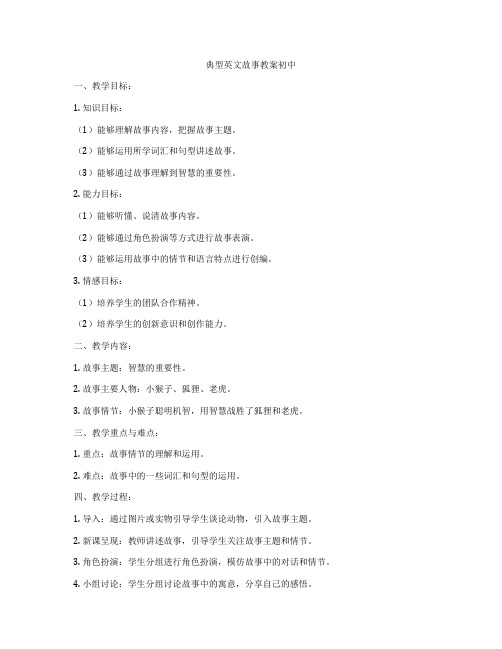
典型英文故事教案初中一、教学目标:1. 知识目标:(1)能够理解故事内容,把握故事主题。
(2)能够运用所学词汇和句型讲述故事。
(3)能够通过故事理解到智慧的重要性。
2. 能力目标:(1)能够听懂、说清故事内容。
(2)能够通过角色扮演等方式进行故事表演。
(3)能够运用故事中的情节和语言特点进行创编。
3. 情感目标:(1)培养学生的团队合作精神。
(2)培养学生的创新意识和创作能力。
二、教学内容:1. 故事主题:智慧的重要性。
2. 故事主要人物:小猴子、狐狸、老虎。
3. 故事情节:小猴子聪明机智,用智慧战胜了狐狸和老虎。
三、教学重点与难点:1. 重点:故事情节的理解和运用。
2. 难点:故事中的一些词汇和句型的运用。
四、教学过程:1. 导入:通过图片或实物引导学生谈论动物,引入故事主题。
2. 新课呈现:教师讲述故事,引导学生关注故事主题和情节。
3. 角色扮演:学生分组进行角色扮演,模仿故事中的对话和情节。
4. 小组讨论:学生分组讨论故事中的寓意,分享自己的感悟。
5. 创意改编:学生分组创编故事,可以使用故事中的角色和情节,也可以自己创新。
6. 展示和评价:各小组展示自己的创编故事,其他学生和教师进行评价。
五、课后作业:1. 复述故事:学生回家后向家长复述故事内容。
2. 写一篇关于智慧重要性的短文。
3. 家长评价学生的表现,教师进行反馈。
六、教学评价:1. 学生对故事情节的理解程度。
2. 学生在角色扮演和创编故事中的表现。
3. 学生对智慧重要性的认识和感悟。
通过本节课的学习,希望学生能够理解智慧的重要性,培养自己的创新意识和创作能力,同时在团队合作中不断提升自己的综合语言运用能力。
英语课堂故事教学案例范文
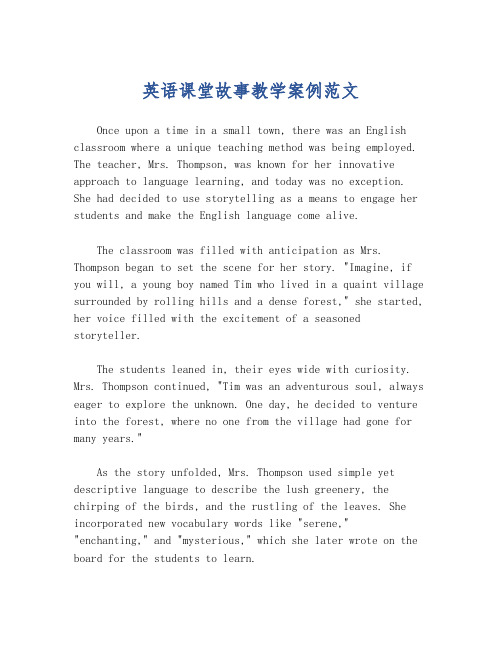
英语课堂故事教学案例范文Once upon a time in a small town, there was an English classroom where a unique teaching method was being employed. The teacher, Mrs. Thompson, was known for her innovative approach to language learning, and today was no exception. She had decided to use storytelling as a means to engage her students and make the English language come alive.The classroom was filled with anticipation as Mrs. Thompson began to set the scene for her story. "Imagine, if you will, a young boy named Tim who lived in a quaint village surrounded by rolling hills and a dense forest," she started, her voice filled with the excitement of a seasoned storyteller.The students leaned in, their eyes wide with curiosity. Mrs. Thompson continued, "Tim was an adventurous soul, always eager to explore the unknown. One day, he decided to venture into the forest, where no one from the village had gone for many years."As the story unfolded, Mrs. Thompson used simple yet descriptive language to describe the lush greenery, the chirping of the birds, and the rustling of the leaves. She incorporated new vocabulary words like "serene," "enchanting," and "mysterious," which she later wrote on the board for the students to learn.The plot thickened as Tim encountered various challenges in the forest, each one teaching him a valuable lesson. Mrs. Thompson used these situations to introduce different grammatical structures and sentence patterns. For instance, when Tim helped a squirrel retrieve its acorn, she used the past simple tense to describe the action: "Tim helped the squirrel retrieve its acorn."The students were not just passive listeners; they were encouraged to participate by asking questions, making predictions, and even suggesting alternative endings to the story. This interactive approach made the learning process dynamic and engaging.As the lesson progressed, Mrs. Thompson transitioned from storytelling to role-playing. She divided the students into groups and assigned each group a different part of the story to act out. This allowed the students to practice their speaking skills while also reinforcing the new vocabulary and grammar they had learned.The class ended with a lively discussion where the students shared their thoughts on the story's moral and how they could apply the lessons learned to their own lives. Mrs. Thompson concluded the session by summarizing the key language points and encouraging the students to continue practicing at home.This storytelling approach in Mrs. Thompson's English class not only made learning English fun and interactive but also helped the students develop a deeper understanding ofthe language. It was a testament to the power of creativity and engagement in education, and the students left the class with a newfound love for English and a story they would never forget.。
英语老师教学故事案例范文

英语老师教学故事案例范文Teaching stories in English class is an effective way to engage students and make learning more enjoyable. 用故事案例来教学英语课是一种有效的方法,可以吸引学生的注意力,使学习更加愉快。
By incorporating stories into the curriculum, teachers can create a more interactive and dynamic learning environment. 通过将故事融入到课程中,教师可以创造出一个更具互动性和活力的学习环境。
This approach not only helps students improve their language skills, but also fosters critical thinking and enhances cultural awareness. 这种教学方法不仅有助于学生提高语言技能,还培养了批判性思维,并增强了文化意识。
Moreover, storytelling allows students to connect with the material on a deeper level, making the learning experience more meaningful and memorable. 此外,讲故事可以让学生在更深层次上与学习材料产生联系,使学习体验更有意义和难忘。
One of the key benefits of using storytelling in English class is that it helps students develop their language skills in a more natural and immersive way. 使用故事讲述在英语课堂上的一个重要好处是,它能帮助学生以一种更自然和沉浸的方式提高语言技能。
初中英语故事教案

故事教案:《小猪快跑》一、教学目标:1. 学生能够理解故事内容,把握故事情节。
2. 学生能够运用所学英语知识进行日常交流。
3. 学生能够通过故事学习到坚持、勇敢、聪明的品质。
二、教学内容:1. 故事主题:勇敢、坚持、聪明2. 故事主要人物:小猪、狐狸、农夫3. 故事情节:小猪被农夫捉住,打算第二天做成猪肉粥。
小猪聪明地请求农夫让它先去洗干净,农夫同意了。
小猪趁机逃跑,狐狸追赶,但小猪机智地逃脱了狐狸的追赶。
三、教学重点与难点:1. 重点:学生能够理解故事主题,把握故事情节。
2. 难点:学生能够运用所学英语知识进行日常交流。
四、教学步骤:1. 热身活动(5分钟):教师与学生进行简单的英语对话,营造轻松的课堂氛围。
2. 新课导入(10分钟):教师简要介绍故事情节,引导学生关注故事主题。
3. 故事讲解(15分钟):教师分段讲解故事,引导学生跟读并模仿语音语调。
4. 角色扮演(15分钟):学生分组扮演故事中的角色,进行情景剧表演。
5. 小组讨论(10分钟):学生分组讨论故事中的主题,分享自己的感悟。
6. 总结与作业(5分钟):教师总结故事主题,布置相关作业。
五、教学评价:1. 学生对故事情节的理解程度。
2. 学生参与课堂活动的积极程度。
3. 学生运用英语进行日常交流的能力。
4. 学生对故事主题的感悟和理解。
六、教学资源:1. 故事课件或黑板。
2. 角色头饰。
3. 与故事相关的图片或视频。
七、教学建议:1. 针对不同学生的英语水平,可以适当调整教学内容和难度。
2. 在角色扮演环节,鼓励学生大胆开口,注重语音语调的模仿。
3. 在小组讨论环节,引导学生深入思考故事主题,分享自己的感悟。
4. 作业布置要有针对性,注重巩固所学知识。
通过本节课的学习,希望学生能够理解故事主题,把握故事情节,同时能够运用所学英语知识进行日常交流,并从中学习到坚持、勇敢、聪明的品质。
初中英语故事课程教案模板
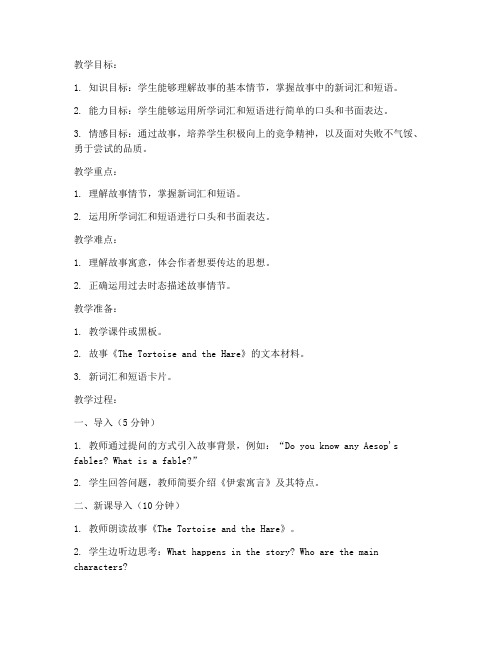
教学目标:1. 知识目标:学生能够理解故事的基本情节,掌握故事中的新词汇和短语。
2. 能力目标:学生能够运用所学词汇和短语进行简单的口头和书面表达。
3. 情感目标:通过故事,培养学生积极向上的竞争精神,以及面对失败不气馁、勇于尝试的品质。
教学重点:1. 理解故事情节,掌握新词汇和短语。
2. 运用所学词汇和短语进行口头和书面表达。
教学难点:1. 理解故事寓意,体会作者想要传达的思想。
2. 正确运用过去时态描述故事情节。
教学准备:1. 教学课件或黑板。
2. 故事《The Tortoise and the Hare》的文本材料。
3. 新词汇和短语卡片。
教学过程:一、导入(5分钟)1. 教师通过提问的方式引入故事背景,例如:“Do you know any Aesop's fables? What is a fable?”2. 学生回答问题,教师简要介绍《伊索寓言》及其特点。
二、新课导入(10分钟)1. 教师朗读故事《The Tortoise and the Hare》。
2. 学生边听边思考:What happens in the story? Who are the main characters?三、词汇学习(15分钟)1. 教师引导学生找出故事中的新词汇和短语,如:slowly, quickly, lazy, tired, win, lose 等。
2. 学生跟读并模仿发音。
3. 教师解释词汇含义,并举例说明在句子中的运用。
四、语法学习(10分钟)1. 教师引导学生分析故事中的时态,例如:一般过去时。
2. 学生练习用一般过去时描述故事情节。
五、故事理解(10分钟)1. 教师提问,引导学生回顾故事情节,如:Who won the race? Why did the hare lose?2. 学生回答问题,教师总结故事寓意。
六、课堂活动(15分钟)1. 学生分角色朗读故事。
2. 教师组织学生进行角色扮演,加深对故事情节的理解。
小学英语课堂故事教案模板

教学目标:1. 学生能够听懂并复述故事内容。
2. 学生能够运用所学词汇和句型进行简单的角色扮演。
3. 培养学生阅读兴趣,提高阅读能力。
教学重点:1. 听懂故事内容。
2. 学会故事中的新词汇和句型。
3. 进行角色扮演。
教学难点:1. 学生理解故事情节。
2. 学生运用所学词汇和句型进行角色扮演。
教学准备:1. 教师准备故事文本、PPT、图片等教学资源。
2. 学生准备故事文本、彩笔、画纸等。
教学过程:一、导入1. 教师用简单的英语问候学生,活跃课堂气氛。
2. 教师展示故事图片,引导学生猜测故事内容。
二、新课导入1. 教师朗读故事,让学生初步了解故事内容。
2. 教师提问,检查学生对故事内容的理解。
三、学习故事中的新词汇和句型1. 教师带领学生学习故事中的新词汇和句型,并进行讲解。
2. 学生跟读,巩固所学知识。
四、角色扮演1. 教师将学生分成小组,每组选出一个角色。
2. 学生根据故事内容,运用所学词汇和句型进行角色扮演。
3. 教师巡视指导,鼓励学生积极参与。
五、总结与拓展1. 教师引导学生回顾故事内容,总结故事中的道理。
2. 学生分享自己对故事的感悟。
3. 教师布置课后作业,如:画一幅与故事相关的图画,写一篇故事续写等。
教学评价:1. 学生对故事内容的理解程度。
2. 学生运用所学词汇和句型的能力。
3. 学生在角色扮演中的表现。
4. 学生对课后作业的完成情况。
教学反思:1. 教师应根据学生的实际情况,调整教学进度和方法。
2. 注重培养学生的阅读兴趣,提高学生的阅读能力。
3. 鼓励学生积极参与课堂活动,提高学生的口语表达能力。
英语教学故事教案模板范文

Subject: English Language ArtsGrade Level: Grade 5Unit Topic: My Favorite AnimalLesson Title: "The Tale of the Brave Panda"Objective:- To improve students' listening skills by engaging them in a story about an animal.- To enhance vocabulary acquisition related to animals and bravery.- To encourage students to express their opinions and feelings about the story.Materials:- Projector or whiteboard for displaying images and text.- Audio recording of the story.- Copies of the story text for each student.- Vocabulary list related to animals and bravery.- Drawing paper and colored pencils for creative activities.Preparation:- Download or create an audio recording of the story "The Tale of the Brave Panda."- Prepare visual aids to accompany the story.- Print out the story text and vocabulary list for each student.- Arrange the classroom for group activities and individual reflection.Duration: 1 hourTeaching Procedures:1. Introduction (5 minutes)- Begin with a warm-up activity: Ask students to brainstorm different animals they know and what makes them unique.- Introduce the lesson topic: "Today, we are going to listen to a story about an animal that is both brave and special."2. Listening Activity (15 minutes)- Play the audio recording of the story "The Tale of the Brave Panda."- After listening, pause the recording and ask students to summarize the story in their own words.- Discuss the main characters, setting, and plot of the story.3. Vocabulary Development (10 minutes)- Distribute the vocabulary list related to animals and bravery.- Go through each word and ask students to provide examples of how they might use the word in a sentence.- Have students work in pairs to create a sentence using two new words from the list.4. Reading Activity (10 minutes)- Distribute copies of the story text.- Read the story aloud to the class, pausing occasionally to discuss the text.- Encourage students to follow along and highlight or underline new vocabulary words.5. Group Discussion (10 minutes)- Divide the class into small groups.- Each group discusses their favorite part of the story and why.- Groups then present their discussions to the class.6. Creative Activity (10 minutes)- Instruct students to draw a picture of their favorite animal, inspired by the story.- Have them write a sentence or two describing the animal's bravery or uniqueness.7. Conclusion (5 minutes)- Ask students to share their drawings and sentences with the class.- Summarize the main points of the lesson and reinforce the importance of bravery and the uniqueness of animals.Assessment:- Observe students' participation in the listening, vocabulary, and reading activities.- Evaluate the quality of the sentences created during the vocabulary development section.- Assess the creativity and thoughtfulness of the drawings and sentences in the creative activity.Extension Activities:- Assign a homework task to write a short story about a brave animal of their choice.- Organize a class presentation where students share their stories and drawings.Note: This template can be adapted to different story topics and grade levels by adjusting the complexity of the vocabulary, the depth of the discussions, and the activities involved.。
小学英语教学故事(共5篇)

小学英语教学故事(共5篇)第一篇:小学英语教学故事小学英语教学故事——“意外”的精彩在每一次的教学工作中,总能收获着属于每一次课堂的智慧。
在一节英语课上,教学内容是What are you doing?当课堂很顺利地进行到一半时,突然进行到一半时,突然有一位同学叫起来:“老师,B同学在画画!”话音刚落,全班同学眼光一齐投向那位同学。
我一看画画的同学,原来是一位被列为“学习困难户”的学生。
当时我一看到他,心里有些许的生气。
而此时他却没放下手中的笔,还在继续画画。
我知道,当时如果一把夺过他的画纸撕掉,或是大声责骂他几句,都能让自己解气。
但转念一想,我又强压心中的怒火,走到他边上,语气平和地问:“What are you doing?(你在做什么呢?)也许他也没想到我会这样问他,或许是他根本没听懂我的问话,还是不知道怎么回答,他没做声。
我转向其他学生问道:“Who can help him?马上有同学举手做答:“He is drawing.”我请B同学说:“I’m drawing.”他轻声地跟着说了一遍,我对他点点头,加上一句:“Very good!”在我们每天的教学过程中,经常会遇到类似的事情:有些学生课前没准备好学习用品;有些学生上课喜欢搞点“小笑话”;有些学生上课注意力不集中,做小动作或干别的事情等等。
面对这些情况,我们应该怎么处理呢?如果老师采取强制的手段来制止这种纪律问题的话,就会产生不良的结果:不但无法让学生真正信服你,反而拉开了师生之间的距离,树立了老师在学生心中的强权的形象,学生无法接受老师的观点,会产生对英语产生敬而远之的态度;那样就无法培养学生学习英语的兴趣,还会狠狠地挫伤他们的积极性,为学生以后的英语学习划上了一道永不磨灭的伤痕。
英语老师在某种意义上就代表了英语的某些特征,如果英语老师不能产生对学生的亲和力,就会给学生留下“英语就像英语老师那样没意思”的印象。
确实,对学生应该严格要求,面对学生违纪要及时提醒纠正,但我们确实可以不用讽刺、挖苦、嘲笑甚至体罚的方法,因为这样做只能引起学生的逆反心理,结果适得其反。
初中英语教案故事范文模板

教学目标:1. 理解故事内容,掌握故事中的生词和短语。
2. 培养学生的阅读理解能力和口语表达能力。
3. 引导学生了解阿拉伯文化,拓宽学生的国际视野。
教学重点:1. 生词和短语:magic lamp、genie、three wishes、happiness、greed。
2. 句型:What would you wish for if you had three wishes?教学难点:1. 理解故事中的人物性格和情节发展。
2. 模仿故事中的角色进行角色扮演。
教学准备:1. 故事文本《The Magic Lamp》2. 多媒体课件3. 彩色卡片教学过程:一、导入1. 教师展示一张神秘的油灯图片,引导学生猜测故事内容。
2. 学生自由发言,教师总结并引入故事主题。
二、新课导入1. 教师朗读故事《The Magic Lamp》,学生跟读。
2. 教师提问,检查学生对故事内容的理解。
问题:(1)What is the magic lamp?(2)Who is the genie?(3)What does the boy wish for in the first wish?(4)What does the boy wish for in the second wish?(5)What happens to the boy in the end?三、词汇教学1. 教师展示故事中的生词和短语,并解释其含义。
2. 学生跟读并模仿发音。
3. 教师带领学生进行句子练习,巩固词汇。
四、故事复述1. 学生分组,每组选择一个角色进行角色扮演。
2. 学生根据故事内容进行复述,其他学生倾听并纠正错误。
五、讨论与拓展1. 教师提问,引导学生讨论故事中的道德寓意。
问题:What can we learn from the story?2. 学生自由发言,分享自己的看法。
六、作业布置1. 请学生将故事内容用英语写下来。
2. 请学生思考,如果自己拥有三个愿望,会希望得到什么?教学反思:本节课通过故事教学,让学生了解了阿拉伯文化,培养了学生的阅读理解能力和口语表达能力。
高中英语故事教案设计模板
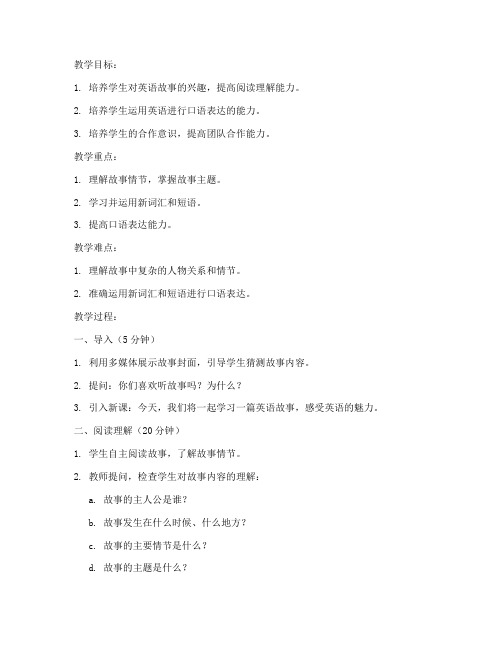
教学目标:1. 培养学生对英语故事的兴趣,提高阅读理解能力。
2. 培养学生运用英语进行口语表达的能力。
3. 培养学生的合作意识,提高团队合作能力。
教学重点:1. 理解故事情节,掌握故事主题。
2. 学习并运用新词汇和短语。
3. 提高口语表达能力。
教学难点:1. 理解故事中复杂的人物关系和情节。
2. 准确运用新词汇和短语进行口语表达。
教学过程:一、导入(5分钟)1. 利用多媒体展示故事封面,引导学生猜测故事内容。
2. 提问:你们喜欢听故事吗?为什么?3. 引入新课:今天,我们将一起学习一篇英语故事,感受英语的魅力。
二、阅读理解(20分钟)1. 学生自主阅读故事,了解故事情节。
2. 教师提问,检查学生对故事内容的理解:a. 故事的主人公是谁?b. 故事发生在什么时候、什么地方?c. 故事的主要情节是什么?d. 故事的主题是什么?3. 学生分享阅读感受,教师点评并总结。
三、词汇学习(10分钟)1. 教师带领学生分析故事中的新词汇和短语,并举例说明。
2. 学生分组,运用新词汇和短语进行口头表达。
四、口语表达(15分钟)1. 教师设置情景,让学生运用故事中的新词汇和短语进行口语表达。
2. 学生分组进行角色扮演,展示所学内容。
3. 教师点评并给予鼓励。
五、总结与作业(5分钟)1. 教师总结本节课所学内容,强调重点和难点。
2. 布置作业:a. 复习故事内容,思考故事主题。
b. 收集与故事主题相关的英语词汇和短语,进行拓展学习。
教学反思:1. 本节课通过故事导入,激发了学生的学习兴趣,提高了学生的阅读理解能力。
2. 通过词汇学习和口语表达环节,学生掌握了新词汇和短语,提高了口语表达能力。
3. 在角色扮演环节,学生积极参与,培养了团队合作意识。
改进措施:1. 在导入环节,可以增加互动环节,让学生更投入地参与到课堂中来。
2. 在词汇学习环节,可以采用多种教学方法,如游戏、歌曲等,提高学生的学习兴趣。
3. 在口语表达环节,可以增加情景模拟环节,让学生在实际情境中运用所学知识。
小学英语故事教学的实践(3篇)
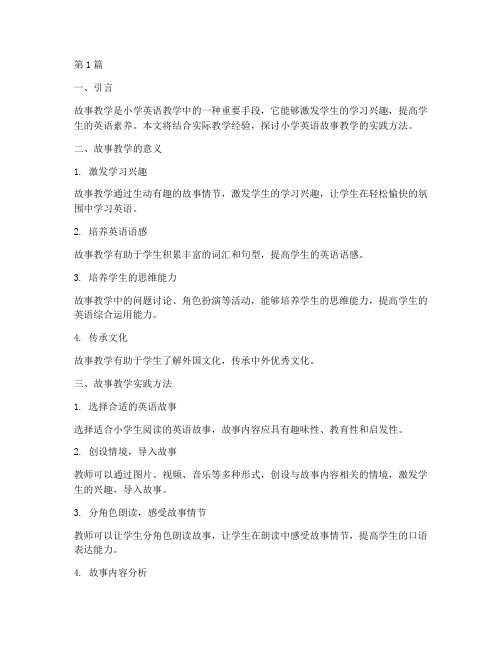
第1篇一、引言故事教学是小学英语教学中的一种重要手段,它能够激发学生的学习兴趣,提高学生的英语素养。
本文将结合实际教学经验,探讨小学英语故事教学的实践方法。
二、故事教学的意义1. 激发学习兴趣故事教学通过生动有趣的故事情节,激发学生的学习兴趣,让学生在轻松愉快的氛围中学习英语。
2. 培养英语语感故事教学有助于学生积累丰富的词汇和句型,提高学生的英语语感。
3. 培养学生的思维能力故事教学中的问题讨论、角色扮演等活动,能够培养学生的思维能力,提高学生的英语综合运用能力。
4. 传承文化故事教学有助于学生了解外国文化,传承中外优秀文化。
三、故事教学实践方法1. 选择合适的英语故事选择适合小学生阅读的英语故事,故事内容应具有趣味性、教育性和启发性。
2. 创设情境,导入故事教师可以通过图片、视频、音乐等多种形式,创设与故事内容相关的情境,激发学生的兴趣,导入故事。
3. 分角色朗读,感受故事情节教师可以让学生分角色朗读故事,让学生在朗读中感受故事情节,提高学生的口语表达能力。
4. 故事内容分析教师引导学生分析故事内容,提炼故事主题,让学生学会从故事中获取信息,提高学生的阅读理解能力。
5. 角色扮演,体验故事教师可以组织学生进行角色扮演,让学生亲身体验故事中的角色,提高学生的英语口语表达能力和表演能力。
6. 故事续写,发挥想象力教师可以让学生发挥想象力,续写故事,培养学生创造性思维。
7. 故事总结,巩固知识教师引导学生总结故事中的重点词汇、句型,巩固学生的英语知识。
8. 故事延伸,拓展知识教师可以结合故事内容,拓展相关知识,让学生了解更多文化背景,拓宽学生的视野。
四、案例分析1. 教学内容:《The Ugly Duckling》2. 教学目标:(1)让学生了解故事内容,学会表达故事情节。
(2)让学生了解天鹅的成长过程,培养积极向上的心态。
3. 教学过程:(1)导入:教师播放《The Ugly Duckling》的动画片,激发学生的兴趣。
初中英语朗读作品故事教案
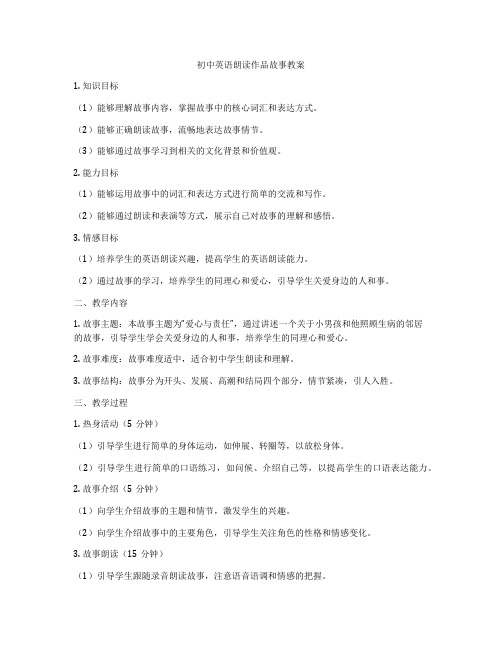
初中英语朗读作品故事教案1. 知识目标(1)能够理解故事内容,掌握故事中的核心词汇和表达方式。
(2)能够正确朗读故事,流畅地表达故事情节。
(3)能够通过故事学习到相关的文化背景和价值观。
2. 能力目标(1)能够运用故事中的词汇和表达方式进行简单的交流和写作。
(2)能够通过朗读和表演等方式,展示自己对故事的理解和感悟。
3. 情感目标(1)培养学生的英语朗读兴趣,提高学生的英语朗读能力。
(2)通过故事的学习,培养学生的同理心和爱心,引导学生关爱身边的人和事。
二、教学内容1. 故事主题:本故事主题为“爱心与责任”,通过讲述一个关于小男孩和他照顾生病的邻居的故事,引导学生学会关爱身边的人和事,培养学生的同理心和爱心。
2. 故事难度:故事难度适中,适合初中学生朗读和理解。
3. 故事结构:故事分为开头、发展、高潮和结局四个部分,情节紧凑,引人入胜。
三、教学过程1. 热身活动(5分钟)(1)引导学生进行简单的身体运动,如伸展、转圈等,以放松身体。
(2)引导学生进行简单的口语练习,如问候、介绍自己等,以提高学生的口语表达能力。
2. 故事介绍(5分钟)(1)向学生介绍故事的主题和情节,激发学生的兴趣。
(2)向学生介绍故事中的主要角色,引导学生关注角色的性格和情感变化。
3. 故事朗读(15分钟)(1)引导学生跟随录音朗读故事,注意语音语调和情感的把握。
(2)在朗读过程中,引导学生关注故事的情节和角色的情感变化,理解故事的主题。
4. 故事理解(10分钟)(1)引导学生回答关于故事的问题,检查学生对故事的理解程度。
(2)引导学生讨论故事中的角色和情节,引导学生从不同的角度看待故事。
5. 故事表演(10分钟)(1)将学生分成小组,每个小组选择一个角色进行表演。
(2)引导学生根据故事情节和角色的性格进行表演,注意语音语调和情感的把握。
6. 总结与反思(5分钟)(1)引导学生总结故事的主题和情节,反思自己在故事中学到的知识和价值观。
初中英语故事分享教案模板

课时:2课时年级:初中教材:《英语课程标准》教学目标:1. 学生能够通过听、说、读、写等活动,理解故事内容,提高英语阅读理解能力。
2. 学生能够运用所学词汇和语法知识,进行口头和书面表达,提高英语口语和写作能力。
3. 培养学生的合作意识,提高学生参与课堂活动的积极性。
教学重点:1. 学生能够理解故事内容,掌握故事中的生词和短语。
2. 学生能够运用所学词汇和语法知识,进行口头和书面表达。
教学难点:1. 学生能够正确运用语法知识,进行书面表达。
2. 学生能够灵活运用所学词汇,进行口头表达。
教学过程:第一课时:一、导入1. 教师展示故事封面,引导学生猜测故事内容。
2. 学生分享自己的猜测,教师简要介绍故事背景。
二、阅读故事1. 学生自由阅读故事,找出故事中的生词和短语。
2. 教师带领学生分析故事中的生词和短语,并讲解其含义和用法。
3. 学生再次阅读故事,加深对故事内容的理解。
三、讨论故事1. 教师提问,引导学生讨论故事中的情节、人物关系等。
2. 学生分组讨论,分享自己的观点,教师巡视指导。
四、角色扮演1. 学生根据故事内容,分组进行角色扮演。
2. 教师巡回指导,纠正学生的发音和语法错误。
五、总结1. 教师总结故事中的生词和短语,强调重点和难点。
2. 学生分享自己在课堂上的收获和感悟。
第二课时:一、复习1. 教师提问,检查学生对故事内容的掌握程度。
2. 学生回答问题,教师点评。
二、口头表达1. 学生分组,用英语复述故事内容。
2. 教师巡视指导,纠正学生的发音和语法错误。
三、书面表达1. 学生根据故事内容,用英语写一篇短文。
2. 教师指导学生修改作文,注意语法和拼写错误。
四、课堂展示1. 学生分组展示自己的短文,其他学生评价。
2. 教师点评学生的表现,总结本次课堂活动。
五、作业布置1. 学生回家后,复习故事内容,背诵故事中的精彩片段。
2. 学生完成课后练习,巩固所学知识。
教学反思:1. 教师在教学中要注意激发学生的学习兴趣,提高学生的参与度。
三只小猪英语教学案例(2篇)

第1篇IntroductionThe story of "The Three Little Pigs" is a classic fairy tale that has been cherished by children and adults alike for generations. It is a tale of bravery, intelligence, and the consequences of one's actions. This teaching case outlines how to integrate the story of "The Three Little Pigs" into an English language classroom, focusing on vocabulary building, comprehension skills, and creative expression.ObjectiveThe primary objective of this teaching case is to help students improve their English language skills through the exploration of the story of "The Three Little Pigs." Specific goals include:1. Enhancing vocabulary acquisition related to houses, animals, and actions.2. Developing comprehension skills through reading, listening, and discussing the story.3. Encouraging creative expression through role-playing, storytelling, and art activities.Materials- Copies of "The Three Little Pigs" storybook- Picture cards depicting houses, animals, and actions- Vocabulary cards- Whiteboard and markers- Construction paper, crayons, and glue sticks for art activitiesLesson Plan1. Introduction (10 minutes)- Begin the lesson by introducing the story of "The Three Little Pigs." Use a picture book or a short video clip to engage the students' interest.- Ask the students what they already know about the story and what they think might happen.2. Vocabulary Building (15 minutes)- Introduce new vocabulary related to the story, such as "house," "stick," "huff," "puff," and "blow."- Use picture cards to illustrate each word and have the students repeat the words after you.- Have the students create a simple sentence using each new word, for example, "The wolf blows the house down."3. Reading Comprehension (20 minutes)- Read the story of "The Three Little Pigs" aloud to the class, pausing to ask questions about the story.- Use the vocabulary cards to help students understand new words.- Discuss the story's plot, characters, and moral.4. Listening Comprehension (15 minutes)- Play a recorded version of the story for the students to listen to.- After listening, ask the students to retell the story or answer questions about what they heard.- Use this opportunity to reinforce the vocabulary and comprehension skills learned in the previous activities.5. Creative Expression (20 minutes)- Divide the class into small groups and assign each group a character from the story.- Have each group create a diorama or poster depicting their character's role in the story.- Encourage the students to use the vocabulary they learned and to be creative with their artwork.6. Role-Playing (15 minutes)- Have the students act out the story using their dioramas or posters as props.- Assign roles to each student and have them practice their lines.- Perform the role-play in front of the class, with each group taking turns.7. Conclusion (5 minutes)- Conclude the lesson by asking the students what they learned from the story.- Encourage the students to reflect on the moral of the story and how it applies to their own lives.Assessment- Observe the students' participation in vocabulary building, reading comprehension, listening comprehension, creative expression, and role-playing activities.- Collect the dioramas or posters created by the students to assesstheir understanding of the story and their ability to express themselves creatively.- Evaluate the students' ability to retell the story and answer questions about it.ConclusionThe story of "The Three Little Pigs" provides an excellent opportunity for English language learners to engage with the language in a meaningful and fun way. By incorporating vocabulary building,comprehension skills, and creative expression into the lesson, students can develop their English language abilities while also enjoying the classic tale.第2篇I. IntroductionThe Three Little Pigs is a classic fairy tale that has been told and retold for generations. It is a perfect tool for teaching English language learners, as it incorporates various language skills such as listening, speaking, reading, and writing. This case study focuses on a lesson plan designed to teach English to primary school students using the story of The Three Little Pigs.II. ObjectivesBy the end of this lesson, students will be able to:1. Understand the plot and characters of The Three Little Pigs.2. Use simple English sentences to retell the story.3. Identify and use vocabulary related to houses and animals.4. Engage in a group discussion about the story's moral.5. Create their own version of The Three Little Pigs using drawing and writing.III. Materials- The Three Little Pigs storybook or picture book- Flashcards with images of houses, animals, and characters- Whiteboard and markers- Colored pencils and paper for drawing- Writing materials (pens, pencils, paper)IV. Lesson ProcedureA. Warm-Up (10 minutes)1. Greeting: Begin the class with a friendly greeting and ask students how they are doing.2. Review Vocabulary: Show flashcards with images of houses, animals, and characters from The Three Little Pigs. Ask students to name them in English.3. Listening Activity: Play a short clip from a children's English song related to houses or animals. Encourage students to sing along.B. Introduction to the Story (15 minutes)1. Show the Book: Introduce the story by showing the book to the class and asking students what they think the story is about.2. Read the Story: Read the story of The Three Little Pigs to the class, using a clear and expressive voice.3. Discussion: After reading, ask students questions to check their understanding:- Who are the three little pigs?- What do they build their houses out of?- What happens to the wolf?C. Vocabulary Building (20 minutes)1. Vocabulary Practice: Introduce new vocabulary related to houses and animals using flashcards. Ask students to point to the correct card when you say the word.2. Sentence Construction: Ask students to form simple sentences using the new vocabulary. For example, "The wolf blows the house down."D. Group Activity: Retelling the Story (20 minutes)1. Divide into Groups: Divide the class into small groups.2. Task Assignment: Assign each group a specific part of the story to retell. For example, one group can retell the part where the firstlittle pig builds his house, another group the second little pig, and the last group the third little pig.3. Practice: Give each group time to practice their part.4. Performance: Have each group perform their part of the story to the class.E. Discussion of the Moral (10 minutes)1. Moral Question: Ask the class what they think the moral of the story is.2. Group Discussion: Divide the class into small groups and discuss the moral with each other.3. Class Discussion: Bring the class back together and share their thoughts on the moral of The Three Little Pigs.F. Creative Activity: Create Your Own Three Little Pigs (15 minutes)1. Drawing: Give each student a piece of paper and colored pencils. Ask them to draw their own version of The Three Little Pigs, including the houses and the wolf.2. Writing: Ask students to write a short paragraph describing their drawing and what happens in their version of the story.V. Conclusion1. Recap: Review the main points of the lesson with the class.2. Feedback: Ask students what they liked about the lesson and what they found challenging.3. Homework: Assign a homework task related to the story, such aswriting a new ending for The Three Little Pigs.VI. ReflectionThis lesson plan effectively utilizes the story of The Three Little Pigs to teach English language skills to primary school students. By incorporating various activities, such as reading, vocabulary building, group work, and creative writing, the lesson encourages students to engage with the language in a fun and interactive way. The use of flashcards, drawing, and group discussions helps to reinforce the learning and make the lesson memorable for the students.。
教学故事英语(优选6篇)
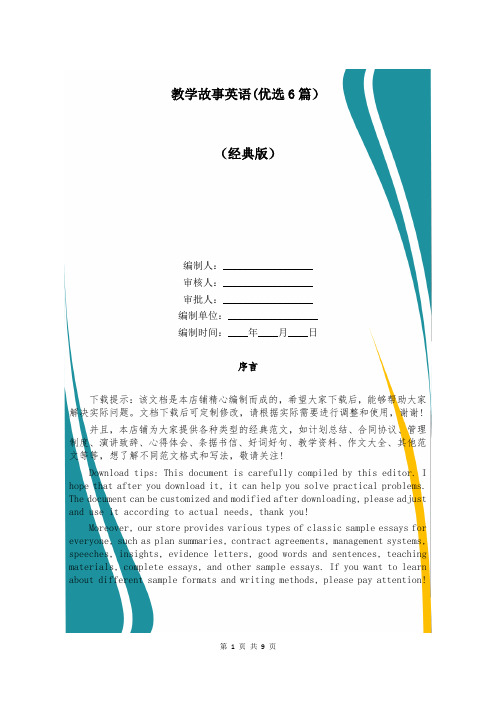
教学故事英语(优选6篇)(经典版)编制人:__________________审核人:__________________审批人:__________________编制单位:__________________编制时间:____年____月____日序言下载提示:该文档是本店铺精心编制而成的,希望大家下载后,能够帮助大家解决实际问题。
文档下载后可定制修改,请根据实际需要进行调整和使用,谢谢!并且,本店铺为大家提供各种类型的经典范文,如计划总结、合同协议、管理制度、演讲致辞、心得体会、条据书信、好词好句、教学资料、作文大全、其他范文等等,想了解不同范文格式和写法,敬请关注!Download tips: This document is carefully compiled by this editor. I hope that after you download it, it can help you solve practical problems. The document can be customized and modified after downloading, please adjust and use it according to actual needs, thank you!Moreover, our store provides various types of classic sample essays for everyone, such as plan summaries, contract agreements, management systems, speeches, insights, evidence letters, good words and sentences, teaching materials, complete essays, and other sample essays. If you want to learn about different sample formats and writing methods, please pay attention!教学故事英语(优选6篇)教学故事英语(1)One year,there was a great famine in the State ofA rich man named Qian Ao set up a stall by the roadside with lots of food,waiting for hungry people to come to give it in After a short while,an awfully hungry man walked over,with his head covered by his sleeve and his shoes tied up with When Qian Ao saw this,he held food in his left hand and tea in his right,shouting: "Hey,come and eat your "The man raised his head suddenly,opening his eyes wide and said angrily: "It is eXactly because I dont want to take this kind of hand-out food given by people shouting charity that I have starved to such an eXtent!"As soon as Qian Ao heard this,he quickly apologized to the But eventually the man starved to death because he was unwilling to take the有一年,齐国发生了特大的饥荒。
幼儿园英语童话故事:大班教学案例分享
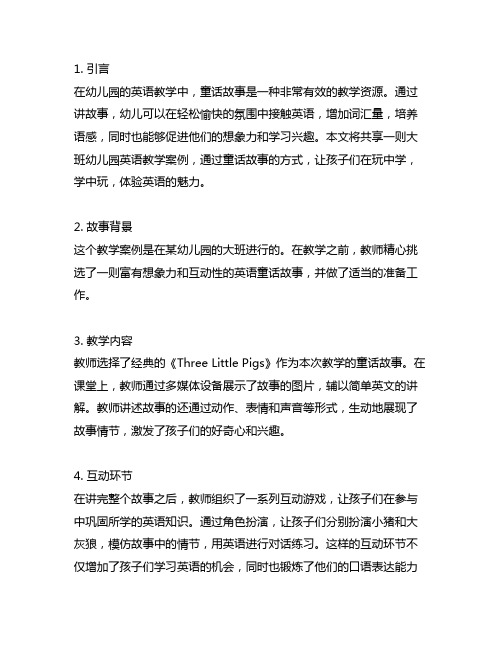
1. 引言在幼儿园的英语教学中,童话故事是一种非常有效的教学资源。
通过讲故事,幼儿可以在轻松愉快的氛围中接触英语,增加词汇量,培养语感,同时也能够促进他们的想象力和学习兴趣。
本文将共享一则大班幼儿园英语教学案例,通过童话故事的方式,让孩子们在玩中学,学中玩,体验英语的魅力。
2. 故事背景这个教学案例是在某幼儿园的大班进行的。
在教学之前,教师精心挑选了一则富有想象力和互动性的英语童话故事,并做了适当的准备工作。
3. 教学内容教师选择了经典的《Three Little Pigs》作为本次教学的童话故事。
在课堂上,教师通过多媒体设备展示了故事的图片,辅以简单英文的讲解。
教师讲述故事的还通过动作、表情和声音等形式,生动地展现了故事情节,激发了孩子们的好奇心和兴趣。
4. 互动环节在讲完整个故事之后,教师组织了一系列互动游戏,让孩子们在参与中巩固所学的英语知识。
通过角色扮演,让孩子们分别扮演小猪和大灰狼,模仿故事中的情节,用英语进行对话练习。
这样的互动环节不仅增加了孩子们学习英语的机会,同时也锻炼了他们的口语表达能力和团队合作意识。
5. 小结与展望通过这个教学案例的共享,我们可以看到幼儿园英语教学中童话故事的重要性和有效性。
童话故事不仅能够让孩子们在愉快的氛围中接触英语,还能够培养他们的语感和想象力。
通过互动游戏,还可以增加孩子们的学习乐趣,提高他们的学习动力。
在未来的教学中,我们希望能够结合更多的童话故事,创造更丰富多彩的英语学习环境,让孩子们在快乐中成长,用英语开启更广阔的世界。
6. 个人观点作为文章写手,我深切认识到童话故事在幼儿园英语教学中的重要性。
通过生动有趣的故事情节,可以吸引孩子们的注意力,让他们在轻松愉快的氛围中学习英语,培养对语言的兴趣。
互动游戏的设置也非常有利于巩固所学的知识,让孩子们在实践中掌握英语表达能力。
我认为在幼儿园的英语教学中,童话故事应该被充分重视和应用,以促进孩子们的全面发展。
典型英文故事幼儿园教案

典型英文故事幼儿园教案一、教学目标1.能够听懂并理解英文故事《The Very Hungry Caterpillar》中的基本情节。
2.能够识别并理解故事中的核心词汇及短语,如caterpillar, apple, pear,butterfly等。
3.能够学习并练习使用数字1-5进行简单的数量统计。
4.能够进行简单的英文口语表达,如介绍自己吃了多少个水果等。
二、教学内容及安排1. 故事讲解在课堂上给学生展示英文故事《The Very Hungry Caterpillar》的图书,并通过讲解、翻译等方式帮助学生理解故事情节及其中的核心词汇和短语。
2. 数量统计在故事讲解之后,引入数字和数量的概念。
教师可以通过手指、卡片、水果等道具,让学生练习数数并进行简单的数量统计。
3. 口语练习通过教师引导,让学生用英语回答一些简单问题,如:•How many apples did the caterpillar eat on Monday?•Did the caterpillar eat any oranges?•How many fruits did you eat today?三、教学重点通过本课程的教学,帮助学生掌握英文故事的基本情节和核心词汇,理解和运用数字和数量的概念,并进行简单的英文口语练习。
四、教学方法本课程采用展示、翻译、数字练习、口语练习等多种教学方法,以帮助学生更好地理解故事,掌握数字和数量的概念,并进行简单的英文口语练习。
五、教学评估通过本课程的教学,教师可以通过以下方式对学生的学习情况进行评估:1.在口语练习环节,教师可以逐一询问学生,并对其回答的准确性和流利性进行评估。
2.在数字练习环节,教师可以通过观察学生进行数字和数量的练习情况,评估学生的练习成果和学习情况。
3.教师可以根据学生的练习情况和口语表达情况等,对学生的学习成果进行总结性评估。
下面是故事内容The Very Hungry Caterpillar1.On Monday, the caterpillar ate one apple.2.On Tuesday, the caterpillar ate two pears.3.On Wednesday, the caterpillar ate three plums.4.On Thursday, the caterpillar ate four strawberries.5.On Friday, the caterpillar ate five oranges.After all this eating, the caterpillar was not a little caterpillar anymore. He was a big, fat caterpillar.On Saturday, the caterpillar ate so much food that he had a stomachache. He ate through one piece of chocolate cake, one ice cream cone, one pickle, one slice of Swiss cheese, one slice of salami, one lollipop, one piece of cherry pie, one sausage, one cupcake, and one slice of watermelon.That night, he had a stomachache and felt very sick. The next day was Sunday again. The caterpillar ate through one nice green leaf, and after that he felt much better. Now, he wasn’t hungry anymore and he wasn’t a little cat erpillar anymore.He was a big, fat caterpillar.最后一句翻译:现在,他既不饿了,也不是一个小毛毛虫了。
典型英文故事教案模板范文

Objective:- To develop students' reading comprehension skills through a narrative text.- To encourage students to use their imagination and creativity.- To foster a love for storytelling and literature.Grade Level: 3rd GradeSubject: English Language ArtsDuration: 1 hourMaterials:- Copies of the story "The Enchanted Forest"- Whiteboard and markers- Colored pencils or crayons- Interactive whiteboard or projector for displaying images related to the story- A map of a forest or a drawing of the enchanted forest- Discussion questions sheetPreparation:1. Make copies of the story "The Enchanted Forest" for each student.2. Prepare a visual aid of a forest or an enchanted forest map.3. Create a discussion questions sheet with open-ended questions to guide the class discussion.4. Familiarize yourself with the story to answer any questions the students might have.Lesson Procedure:1. Introduction (10 minutes)- Begin the lesson by discussing the importance of imagination and creativity in literature.- Ask students to share their favorite stories and why they enjoy them.- Introduce the story "The Enchanted Forest" as a tale of imagination and adventure.2. Reading the Story (15 minutes)- Read the story aloud to the class, ensuring that students follow along.- Pause at appropriate points to ask questions about the story's plot, characters, and setting.- Encourage students to visualize the scenes as they listen.3. Discussion and Analysis (20 minutes)- After reading the story, ask students to share their thoughts and feelings about the story.- Use the discussion questions sheet to guide the conversation.- Questions might include:- What was your favorite part of the story?- How did the characters feel throughout the story?- What challenges did the characters face, and how did they overcome them?- How did the enchanted forest compare to the real forest?4. Creative Activity (15 minutes)- Divide the class into small groups.- Provide each group with colored pencils or crayons and a map or drawing of the enchanted forest.- Instruct the groups to create their own versions of the enchanted forest, adding their own unique elements and characters.- Allow students to share their creations with the class.5. Reflection and Conclusion (10 minutes)- Ask students to reflect on what they learned about imagination and creativity through the story.- Have a class discussion about the importance of imagination in their own lives.- Summarize the main points of the lesson and encourage students to continue using their imagination in their daily activities.Assessment:- Observe students' participation in the discussion and creative activity.- Collect the maps or drawings of the enchanted forest to assess their creativity and understanding of the story.- Provide individual feedback on students' responses during the discussion and their creative work.Follow-up Activity:- Assign a creative writing assignment where students write their own short story set in an enchanted forest, incorporating elements from "The Enchanted Forest" and their own imaginative ideas.。
- 1、下载文档前请自行甄别文档内容的完整性,平台不提供额外的编辑、内容补充、找答案等附加服务。
- 2、"仅部分预览"的文档,不可在线预览部分如存在完整性等问题,可反馈申请退款(可完整预览的文档不适用该条件!)。
- 3、如文档侵犯您的权益,请联系客服反馈,我们会尽快为您处理(人工客服工作时间:9:00-18:30)。
小学英语故事教学作为一名英语老师,要面对很多不同的学生,所以,在教学中一定有很多的趣事发生吧,以下是小编精心准备小学英语教育叙事案例,欢迎大家一起来看看!小学英语教育叙事案例一小学英语课程应从培养学生的学习兴趣入手,最大限度地发挥学生的潜在能力,使学生积极主动地参与学习的全过程,让学生由被动学转为主动学,从中真实感受学习的快乐。
英语教学要照顾到小学生的年龄特点。
这就要求小学的英语教学无论从内容上,还是从形式上均要富有趣味性,以吸引学生的兴趣。
一、听听、说说、做做。
例如,在教完1-10的数字后,我让孩子们伸出手,如果老师发出的指令是:"Ten."则学生用手势表示10,这样既玩了,又复习了数字,一举两得。
又如,在教学五官词语时,我让孩子们一起来做Touch游戏,即老师发指令,学生边做动作,边重复身体部位名称。
如,老师说:"Touch your mouth. "学生边指自己的嘴巴,边说:"Mouth, mouth, this is my mouth."这样既锻炼了学生的听力,又加深了学生的记忆。
二、演演、说说、唱唱。
表演是学习语言的有效途径,小学生更有爱表现的欲望,如在教学Let’s play football.时,让孩子们抓住每种球---篮球和足球的特征,边读单词边做动作,边做动作边找相应的单词卡片,整个课堂非常活跃,学生们的表现力特别强,情绪高涨。
在教学活动中,我还发现孩子们很喜欢唱歌,因此,在教学中,适时地教一些英语歌曲,既可以调动他们学习英语的积极性,又可以增强记忆,活跃气氛。
但是,凡事皆有度,趣味活动也不是万能的,如果教师把握不好时机和深度,那么有时反而会使教学步入误区。
例如,我遇见一个学生,听说他刚开始学英语,就问他:"小猫用英语怎么说?"他回答:"小花猫,喵喵喵,cat cat是小猫。
"我又问他:"苹果怎么说?"他说:"苹果是apple,apple,apple是苹果。
"对他而言,小猫、苹果的英语单词和汉语是一个整体,每次他都必须经过儿歌这段思维才能想起英文单词。
还有,老师常常爱把要学的英语句子编成歌曲教给孩子们唱,这种形式学生很喜欢,可是有的时候单词的发音会因为单纯迎合歌曲的调子而被扭曲,由此导致学生发音不准,反而收不到好的效果。
所以我认为,我们在提高课堂趣味性的同时,一定要把握好时机和方法,让孩子们既学到正确无误的语音、单词和句子,又体验到学习的快乐。
小学英语教育叙事案例二教学几年来,在英语课堂教学中总是觉得学生对英语学习不感兴趣,究其原因是因为学英语需要及大量的单词太乏味太辛苦了,英语教育叙事故事。
是的背英语单词是很辛苦,但是如果我们能把它变得interesting了是不是可以改变这种状态呢。
带着这种想法,我最近在课堂教学中做了一点尝试,一次在教高二选修7第三单元生词时遇到particularly这个单词教了好几遍学生就是读不下来,总是有相当一部分学生有问题,我突然想到最近我正在学习研究单词速记法就说:“谁能想一个好办法把这个单词记住?”过了几秒钟,有一个学生小声地说了什么,我隐隐约约听到好像是说这个单词的,于是我就叫他起来说,于是这个学生就大声说:“party可以有你了。
”我一听,非常高兴地说:“Very good!…”经过讨论最后确定为:“Party上可以有你了就特别了。
”这样一来,即解决了读音问题又和词义有了联系,由于内容很形象所以增加了趣味性,因此就便于记忆了,这样一来课堂就活跃了起来。
看到学生这样兴奋,我顺便讲了一些记忆方面的知识,以期能起到画龙点睛的作用。
能让学生轻松地学习,这也是课标对教学的要求。
既然大多数学生记忆英语单词有困难,为什么我们不能给他们教一些记忆方法呢。
大脑,这个遍布沟回的神秘领域,普通人穷其一生能用到的却不过百分之一二;开发大脑,挖掘大脑潜能,已经成为全人类的一个梦想。
在国外,脑力运动早已兴起,由英国人“大脑先生”托尼?波赞发起的世界记忆力锦标赛更是风行十余年,成为全球最权威的记忆力赛事。
而在中国,这个领域几乎一片空白。
还好近几年来速记在我国已经越来越被关注,记忆方面的书籍也如雨后春笋层出不穷,张杰。
王茂华等记忆大师也进入了世界记忆大赛的前十名行列。
填补了世界记忆领域无中国人的空白。
下面就给大家介绍国内外记忆专家的一些理论、经验和建议。
这些都是他们对快速记忆、提高记忆力和记忆的奥秘等经过多年研究而得出的结论。
记忆法简单来说就是能够缩短我们记忆和回忆过程的技艺和技巧,包括我们常用的定桩法、地点法等等。
记忆法一般都植根于一种理念,即大脑容易记住直观的、图像的、对感观冲击力大的事物,因此只要我们将要记的内容与这些东西联系起来,就很容易记住,且十分清晰,不易遗忘。
记忆过程中有两个要素:第一是重点,第二是联想。
事物可以分为表象和本质两个层面,在记忆时,重点和非重点就是本质和表象的关系。
假如我们的大脑记忆的内容都是重点,那么效率就会高很多,但大多数时候我们看到的只是表象,真正的重点往往隐藏其中。
思维导图可以将事物之间的联系找出来,进而发现关键词,也就是重点。
找出重点后就应该用记忆法进行联想记忆。
学习外语的成功要素主要有三个,一是方法,二是愿望,三是自律。
这三个要素中任何一个的提高,都会加快目标的实现。
当然如果要在同样时间内实现目标,三个要素其中一个要素的增高,也就同时降低对其他两个要素的要求。
比如方法有效性提高,对自律和愿望的要求会降低。
如果自律极大提高,对好方法的要求会降低。
小学英语教育叙事案例三只有在阳光照耀下的小苗才能拙壮的成长。
当然,我们的孩子也是一样。
无论什么样的孩子,无论他是“优等生”还是“差生”,他都渴望得到教师给他的一片“阳光”。
这样他才可以在这片“阳光”下更好的长大,更健康的成长。
从事了十年的教学工作,在工作中遇到了很多事情。
和孩子们之间也发生过很多很多故事。
那本是一节普通的英语课。
但是,至今我都没有忘记那堂课。
因为那堂课,让我知道了我们的“差生”更需要我们教师的关注,更需要我们给他们的天空中多一份阳光,让他们可以感受到教师这个“太阳”的温暖,范文《英语教育叙事故事》。
像平时每节英语课一样,我提前到了教室,等待上课的到来,好给孩子们上课。
课前一样是让孩子们准备好了课上的用品。
但是,我发现有一个孩子他却没有这样做,这个孩子就是一个“差生”。
我强调说:“请同学们把用具准备好”。
而且也故意把这句话的语气说得很重。
但是,他依然没有反应。
这时,恰巧上课了。
所以,我也没再去说这个孩子。
但是,在上课的过程中,他的注意力却是非常的不集中。
而且,还打扰别的同学听课。
“这怎么能可以呢?这不是在扰乱课堂秩序吗?我一定要去制止”。
我这样想到。
但我马上又停住了。
我不可以这样直接去说这个孩子,那样对孩子岂不是一种很大的伤害吗?但是如果不制止又不可以进行正常的上课。
这怎么办呢?此时,我灵机一动。
我这节课讲的内容,需要孩子们来做动作。
那我何不让他来为大家做示范呢?这样他既不会扰乱课堂,而且也会把他带回到课堂中来。
好的,就这样做。
所以,我把那个所谓的“差生”叫到前面来,为大家做示范。
在他做示范的时候,真的让我很吃惊。
他没有了往日的调皮,而是变得特别认真,真的让我好惊讶。
原来他也会是一个认真的孩子。
也许,是我平时太疏忽他了吧。
这真的是我犯的一个错误。
所以,当孩子做完示范的时候,我给了他肯定。
而且也给了他鼓励。
我看到了孩子带着笑容回到了座位上。
回到座位上以后,他没有再继续去调皮,而是把书拿了出来,端正的坐在那里。
真的让我好感动。
原来他也是这样一个乖孩子,也可以在课堂上表现得这么好。
只是以前,他没有这样的机会而已。
这真的是我的一个错误,让孩子失去了很多这样的机会。
过后我一直在想,幸好当看到孩子调皮的那一刻我没有去呵斥他。
而是换了一种方法,去制止了这样的一个场面。
我最大的保护了这个孩子的自尊心。
让这个孩子同时也有了在课堂上表现的机会与勇气。
在那以后的课堂中,我尽量多的给这个孩子机会,同时,也把更多的机会给了“差生”。
我发现这些孩子们在课堂上和以前的感觉真的不一样了。
不再想着如何去调皮,而是想着如何才能完成老师教给的任务,如何才能更好的完成老师提出的问题。
听课的状态也完全不一样了。
我真的好高兴,孩子们可以这样的努力的学习。
尤其是对于这些“差生”来说。
我把更多的机会给了他们,让这些孩子在自己的天空中,可以得到更多一份的阳光,更多一份的温暖。
我们千万不要小看这一份阳光,因为这份看似不起眼的阳光,对我们的这些孩子来说真的是太珍贵了,也太有用了。
让我们多给孩子一份关注,多给孩子一份阳光吧。
让孩子们可以在我们这份阳光的照耀下,可以更加健康拙壮的成长吧!所以,同行们,请不要吝啬我们的这份关注,因为我们真的可以改变我们的孩子。
让孩子们不再“被动”的去学习,而是“主动”的去学习。
让他们把学习不再看做是一种负担,而是一种他们乐于完成的一项工作。
这样我们的孩子才会更加的热爱学习,也才会更加的钟爱英语。
小学英语教育叙事案例四学生学习英语有两个难点:一是记英语单词;二是学习英语语法。
作为英语教师最头痛的是让学生记单词,最无奈的是让学生学习语法,而这两件事我都经历了,虽然现在有些改观,但是还不够理想。
让学生学习英语语法本应该是一件快乐的事情,可是到我那里是乎变得太难了,就像让学生上刀山下火海一样。
记得那一次,午后的阳光照着昏昏欲睡的学生们,我神采飞扬的迈进教室,学生对我的到来没有任何反应,他们是别无选择的坐那里。
我给他们讲了一个我新看的故事:传说苏格兰北部的古城堡和墓地经常闹鬼,有一个人半夜行走不小心掉进了一个新挖的墓坑里,这个坑又深又大,几经努力还是爬不出来,他索性坐在那里,等天亮再说,这时,又有一人经过也掉了进去,这个人使出混身力气也爬不出来。
先掉下来的人实在看不过去,开口道:“别费力气了,你是爬不出去的。
”那人忽然听到说话以为是遇到鬼,吓得魂不附体,手脚并用,三两下竟然爬了上去,惨叫着逃得无影无踪。
我说:“再聪明的方法也不如最笨的行动”。
学生们不语了。
每个人的潜能都是深不可测的,我们没有理由给任何人妄下断言。
你们能行,我相信你们事后想起课上发生的一切,学生做为一个现实的生动的具有创造性的生命体,带着自己的独有的知识,经验等参与课堂教学。
在教学过程中,学生必然会出现各种各样的想法,当学生采用错误的方法,得到错误的结论时。
我们首先要尊重每一个学生,不要遇制他们的想法,也不要简单否定,可以顺着学生的思维探究下去,或者带领学生换一个角度思考,这样我们可以把学生带入另一个精彩世界。
对学生的教育仅仅停留在知识的传授上,这是一个认真的老师;只有把学生的教育做到心里的老师,才是一名称职的老师。
我们教学学生要让学生主动学习,不是被动来学,学生思考没精打采的情况就会减少或没有了。
